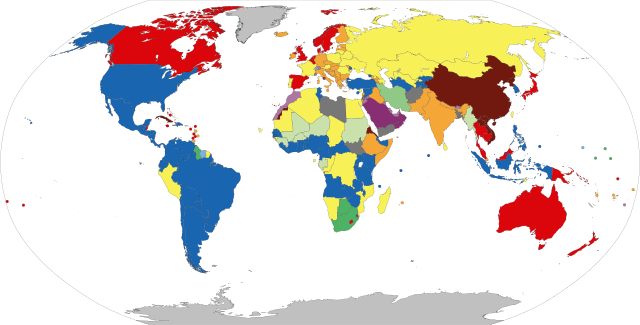Directorial system
Socio-political system with shared executive power From Wikipedia, the free encyclopedia
A directorial system is a regime ruled by a college of several people who jointly exercise the powers of a head of state and/or a head of government.

Parliamentary systems: Head of government is elected or nominated by and accountable to the legislature
Presidential system: Head of government (president) is popularly elected and independent of the legislature
Presidential republic
Hybrid systems:
Semi-presidential republic: Executive president is independent of the legislature; head of government is appointed by the president and is accountable to the legislature
Assembly-independent republic: Head of government (president or directory) is elected by the legislature, but is not accountable to it
Other systems:
Military junta: Committee of military leaders controls the government; constitutional provisions are suspended
Governments with no constitutional basis: No constitutionally defined basis to current regime, i.e. provisional governments or Islamic theocracies
Dependent territories or places without governments
Note: this chart represents the de jure systems of government, not the de facto degree of democracy.
Current directorial systems
Summarize
Perspective
Countries with directorial heads of state sharing ceremonial functions:
 Andorra: co-princes
Andorra: co-princes Bosnia and Herzegovina: presidency
Bosnia and Herzegovina: presidency Eswatini: Ngwenyama and Ndlovukati
Eswatini: Ngwenyama and Ndlovukati San Marino: Captains Regent
San Marino: Captains Regent
Countries governed by a directorial system:
Supranational and subnational entities governed by a directorial system:
 European Union: European Council and European Commission
European Union: European Council and European Commission Northern Ireland: First Minister and deputy First Minister
Northern Ireland: First Minister and deputy First Minister Switzerland: cantons
Switzerland: cantons
Directorial republic in Switzerland
One country now using this form of government is Switzerland,[1] and to a lesser extent San Marino, where directories rule all levels of administration, federal, cantonal and municipal. On the face of it, the Swiss Federal Council might appear to be a typical parliamentary government; technically, however, it is not a meeting of ministers, but a college of heads of state and simultaneously the federal cabinet. The current president of the confederation is in fact only a primus inter pares (first among equals) with representative functions in particular for diplomacy with other States, without any power either of direction or of coordination of the activity of colleagues.[2] The Swiss Federal Council is elected by the Federal Assembly for four years, and is composed of seven members, among whom one is president and one is vice-president on a rotating basis, although these positions are symbolic in normal circumstances. The link between the Swiss managerial system and the presidential system is even more evident for the cantonal governments, where currently all directors are all individually directly elected by the voters.[3]
History
In political history, the term directory, in French directoire, is applied to high collegial institutions of state composed of members styled director. Early directorial systems were the Ambrosian Republic (1447-1450), the Bohemian Revolt (1618–1620), New England Confederation (1643–1686), partially in First Stadtholderless Period of Dutch Republic (1650–1672), Pennsylvania Constitution of 1776 and the Directory of 1795–1799 in France.[4]
The French Directory was inspired by the Pennsylvania Constitution of 1776, which prominently featured a collegial 12-member Supreme Executive Council with the president in fact only primus inter pares (first among equals). Variants of this form of government, based on the French model, were also established in the European regions conquered by France during the French Revolutionary Wars. Directorial systems have a lower presidentialism metric value compared to presidential systems due to lower concentration of political power in the hands of one individual.[5] Military juntas differ from the directorial system by not being elected. Utilizing sortition to select multiple executives can lead to a directorial system.
Former directorial systems
Summarize
Perspective
In the past, countries with elected directories include:
- Bohemian Revolt from 1618 to 1620
 New England Confederation from 1643 to 1686
New England Confederation from 1643 to 1686 Commonwealth of England from 1649 to 1653
Commonwealth of England from 1649 to 1653 Dutch Republic partially in First Stadtholderless Period from 1650 to 1672
Dutch Republic partially in First Stadtholderless Period from 1650 to 1672 Pennsylvania - Supreme Executive Council of the Commonwealth of Pennsylvania from 1777 to 1790
Pennsylvania - Supreme Executive Council of the Commonwealth of Pennsylvania from 1777 to 1790 First French Republic - French Directory from 1795 to 1799
First French Republic - French Directory from 1795 to 1799 Cisalpine Republic from 1795 to 1799
Cisalpine Republic from 1795 to 1799 Cispadane Republic from 1796 to 1797
Cispadane Republic from 1796 to 1797 Roman Republic (1798–1799) from 1798 to 1799
Roman Republic (1798–1799) from 1798 to 1799 Parthenopaean Republic in 1799
Parthenopaean Republic in 1799 Costa Rica - The Town's Legates Junta and High Government Junta from 1821 to 1823
Costa Rica - The Town's Legates Junta and High Government Junta from 1821 to 1823 Roman Republic (1849) from 1849 to 1850 (Triumvirate)
Roman Republic (1849) from 1849 to 1850 (Triumvirate) Ukrainian People's Republic - Directorate of Ukraine from 1918 to 1920[6]
Ukrainian People's Republic - Directorate of Ukraine from 1918 to 1920[6] Republic of China - Nationalist Government - from 1928 to 1947
Republic of China - Nationalist Government - from 1928 to 1947 Uruguay - National Council of Administration and National Council of Government from 1952 to 1967
Uruguay - National Council of Administration and National Council of Government from 1952 to 1967 East Germany - State Council of East Germany from 1960 to 1990
East Germany - State Council of East Germany from 1960 to 1990 Union of Soviet Socialist Republics - Presidium of the Supreme Soviet from 1938 to 1989
Union of Soviet Socialist Republics - Presidium of the Supreme Soviet from 1938 to 1989 Polish People's Republic - State Council of the Polish People's Republic from 1952 to 1989
Polish People's Republic - State Council of the Polish People's Republic from 1952 to 1989
See also
References
Wikiwand - on
Seamless Wikipedia browsing. On steroids.
